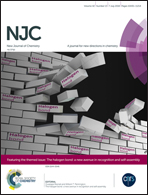A ligand strategic approach with Cu-MOF for enhanced solar light photocatalysis
Abstract
A solar light-active copper-metal organic framework (Cu-MOF) was constructed through a multiple-linker strategy employing 1,2,4,5-benzenetetracarboxylic acid (H4btec) and 4,4′-bis(1-imidazolyl)biphenyl (bimb) as ligands. A reaction mixture consisting of ligands and Cu-metal salts was heated to a critical point in a hydrothermal reactor. The constructed MOF was studied for materials chemistry through successive analytical techniques. The MOF exhibited a planar structure as seen from the topography obtained from electron microscopy and substantiated further by crystallographic analyses. Spectroscopic analyses clearly revealed its remarkable ability to harvest visible light. Photoluminesce demonstrated the effect of organic conjugation over the transition of d–d electrons. Our study clarified the crucial part played by ligand to metal charge transfer in charge-carrier generation. The adopted bi-linker approach enhanced the photoactivity and prolonged the lifetime of the charge carriers. This was evident in a solar photocatalysis experiment through complete removal of 2-chlorophenol in a short period of time. The robust structural stability provided by the linkers was established through thermogravimetric analysis, whereas photostability was established through successive photocatalytic experiments employing the recovered MOF.



 Please wait while we load your content...
Please wait while we load your content...